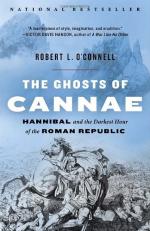|
This section contains 537 words (approx. 2 pages at 400 words per page) |

|
The Ghosts of Cannae: Hannibal and the Darkest Hour of the Roman Republic Summary & Study Guide Description
The Ghosts of Cannae: Hannibal and the Darkest Hour of the Roman Republic Summary & Study Guide includes comprehensive information and analysis to help you understand the book. This study guide contains the following sections:
This detailed literature summary also contains Topics for Discussion and a Free Quiz on The Ghosts of Cannae: Hannibal and the Darkest Hour of the Roman Republic by Robert L. O'Connell.
Robert L. O'Connell describes how Hannibal wiped out the majority of the Roman army in a single battle, the battle at Cannae, in "The Ghosts of Cannae: Hannibal and the Darkest Hour of the Roman Republic" in approximately 200 years B.C. Historians of today research ancient historians and try to figure out where the infamous battle took place, but aside from knowing the general area, they cannot pinpoint a spot since the topography has changed so much over time.
Polybius and Livy were ancient historians who wrote about the battle at Cannae. Polybius knew about battle and he studied historical writings, including some by Fabius Pictor, the Roman senator who was sent to the Delphic oracle to analyze what went wrong after the defeat at Cannae. Livy wasn't a soldier and he wrote history more as a storyteller. The two historians offer many details about Cannae, although there are some inconsistencies in each of their writings.
There were many other historians who wrote about Rome, Carthage, and Cannae. Some of their writing was most likely based on reality while some was not. The author pieced them together with other accounts to glean what might truly have happened.
Rome was a city with soldiers bred to fight. Carthage was a city of merchants. It seemed like Carthage was a true underdog, but it had Hannibal, a brilliant soldier and tactician on its side. When he went into battle, he was prepared. He knew the layout of the land and how to put his adversaries at a disadvantage.
Hannibal only lived in Carthage until he was nine years old. He then moved to Spain with his father, but swore an oath before he left that he would always fight against the Romans. He led an army of soldiers, along with elephants over the Alps into Italy. In addition to battling the elements, they also had to contend with humans. The Gauls, who lived high up in the mountains, opposed them, trying to set up a trap for them, but Hannibal thwarted them by burning fires at night after they had gone home and sneaking over the narrow passes in the dark of night.
Hannibal's army had to forage for food. While some wanted to attack his army, Fabius wanted to corner him until his food ran out so he tried to evade Hannibal and resulting battles.
As Hannibal marched on, some men left. He encouraged them to leave realizing that these would not be strong soldiers and would not be tough enough to handle the rougher parts of the journey. When Hannibal prepared his men for the battle at Cannae, he had his tactical maneuvers carefully planned. He trapped the Romans in a brutal battle, killing the majority of the troops.
Rome struggled to rebuild its army. Meanwhile, it turned its back on the survivors of Cannae who then became the ghosts of Cannae. Scipio, a great leader, recruited and added to his army, rising up against Carthage. Fourteen years after the battle at Cannae, Rome had its revenge as its armies destroyed the Carthaginian army. Hannibal escaped and lived another 20 years but in exile, akin to a ghost of a Roman soldier from Cannae.
Read more from the Study Guide
|
This section contains 537 words (approx. 2 pages at 400 words per page) |

|



